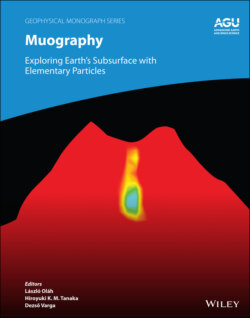Читать книгу Muography - Группа авторов - Страница 25
1.2.10 Limitations of Muography and Potential Geological Targets
ОглавлениеThe limitations of muography include the following: (i) As long as the target has a strong density contrast, this contrast will show upon a muographic image. However, muography only resolves the average density distribution along individual muon paths. Therefore, the user must end up making assumptions or interpretations about the more localized structure along these muon paths or must use more than one detector to resolve the three‐dimensional density structure. (ii) It is limited to near‐surface depths and results are only obtained for the volumes located at elevations higher than the detector. The measurements strongly depend on the nature of the local topography. The detector must be placed on a slope pointing towards a topographically prominent feature of interest. Otherwise, the detector has to be installed underneath the target of interest by utilizing tunnels, boreholes, etc. (iii) The method is in principle limited to ranges of 5–6 km (which limits the size of the potential targets), and (iv) the quality of the resultant muographic image depends on the heterogeneity of the geological environment, the density contrast of the structure being surveyed, and the period of data collection. Dynamics of geofluids such as magma, natural gas, underground water, and sea current will cause time‐dependent variations of the subterranean densimetric heterogeneity. These variations can be captured by time‐sequential muographic observations.
Figure 1.3 Photographs of airborne muography. Distant (a) and close‐up (b) views of the measurements are shown. The white inset in (a) indicates the region of the close‐up view in (b). The distance between the rotor blade and the cliff is a few meters. Exterior (c) and interior (d) views of the apparatus, an integrated form of an array of detectors and a helicopter, are shown. A highly qualified maneuvering skill is required for this operation.
